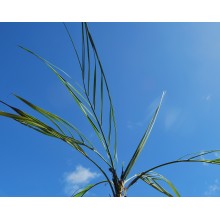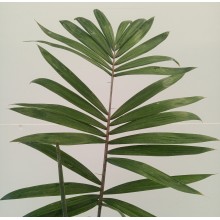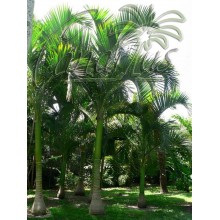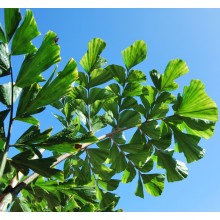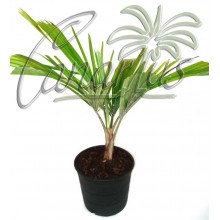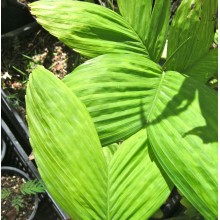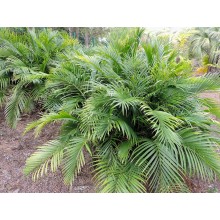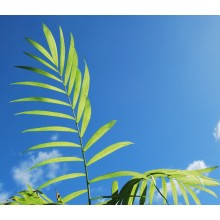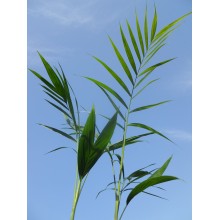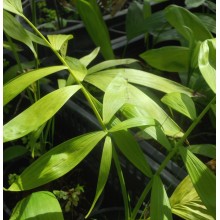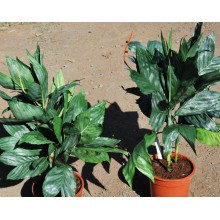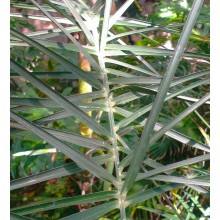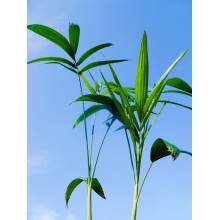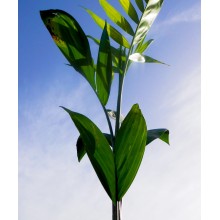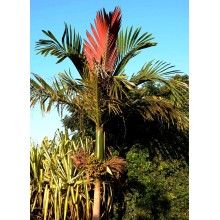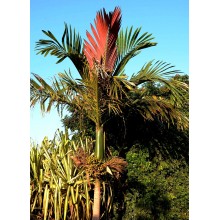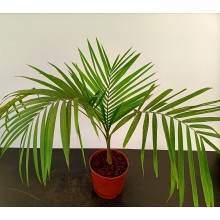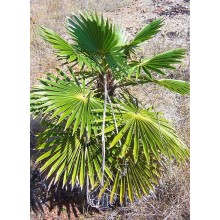Palmeras Hay 101 productos.

La familia de las palmeras, Arecaceae o Palmae, incluye cerca de 2.400 especies, nativas de climas cálidos del mundo, que van desde las delicadas especies tropicales a las palmeras resistentes al frío. Algunas palmas se pueden plantar al aire libre en Europa Central y aguantan fuertes heladas, muy por debajo de los -10 ºC (14 F). Los residentes en los países mediterráneos pueden cultivar un mayor número de especies en el exterior. Algunos cultivadores en la costa sur de Europa están criando colecciones de palmeras al aire libre que incluyen más de 100 especies.
Canarius sólo le enviará palmeras robustas, que se cultivaron en macetas pequeñas para reducir los costos de envío y problemas de preparación. Por ello, trasplántelas a macetas más grandes poco después de recibir el paquete. Esté preparado para darles lo mejor. Algunas palmeras pueden resistir nevadas, algunas pueden vivir en el interior o en macetas, y algunas son muy tropicales. Sólo tiene que elegir una que pueda prosperar en sus condiciones.
¿Qué palmeras pueden crecer en su área? Lea nuestra lista de palmeras resistente al frío para Europa. Visite el blog de Canarius y aprenda más acerca de nuestras palmeras. Verá fotos de los viveros: diferentes tipos de palmeras de Nueva Zelanda, Palmas botella con raíces de calidad superior.
-
Butia X 'archeri x paraguayensis'
Butia X 'archeri x paraguayensis'
This is a cross between two uncommon dwarf palms from eastern central Brazil. It is said to be a natural hybrid because two populations overlap in the same area. Both parents are cold-hardy palms, suitable to plant in milder parts of Europe.
162,00 € -
Calamus henryanus
Calamus henryanus
Climbing palms, or rattans, are incredible living beings which are the most massive of all climbing plants and often a dominant element of rainforests.
43,20 € -
Carpoxylon macrospermum
Carpoxylon macrospermum
Carpoxylon is one of the most elegant palms on earth. It is a solitary palm with a very tall dark green crownshaft and regularly arching leaves. Its spreading inflorescences and large red fruits are also very attractive. At the end of the XX century it was considered extinct until it was rediscovered in the gardens of some natives in Vanuatu, who grew it...
38,00 € -
Caryota obtusa
Caryota obtusa
The largest of all "fishtail" palms. Widespread in the mountains between NE India and N Thailand. Robust solitary trunk with enormous flat "fishtail" bipinnate leaves.
72,00 € -
Ceroxylon quindiuense
Ceroxylon quindiuense
h= 60-80 cm - Cont. 20 cm. Attractive wax palm native to the lower Andes in Ecuador. It has a smooth, slender trunk with a dense crown of flat, spreading leaves, dark green above and silvery below.
58,30 € -
Chamaedorea brachypoda
Chamaedorea brachypoda
Small clumping palm with elegant entire, bifid leaves. Stems are very thin. It is still rare in cultivation, and critically endangered in the wild. It is native to the understorey of wet lowland forest in Guatemala and Honduras. In can grow in tropical to warm Mediterranean conditions - suitable for indoor cultivation, as it can be kept in a pot for its...
42,30 € -
Chamaedorea cataractarum
Chamaedorea cataractarum
Small, attractive, trunkless, relatively slow-growing, clumping palm with dense, cascading, dark green fronds and long thin leaflets.
26,30 € -
Chamaedorea costaricana 'Quetzalteca'
Chamaedorea costaricana 'Quetzalteca'
Uncommon cool-growing palm from high-elevations of Central America. It has a clustering bamboo-like habit. Leaves are lush and attractive. A gem for collectors. As many other chamaedoreas it is a good houseplant.
30,00 € -
Chamaedorea hooperiana
Chamaedorea hooperiana
Clumping, cool-growing palm to 4 m in height. It is found in the rainforest of Veracruz, in Mexico at an elevation of 1000-1500 m.It is hardy to light, short frost and can thrive outdoors in the warmer coastal areas of the Mediterranean.
26,00 € -
Chamaedorea klotzschiana
Chamaedorea klotzschiana
This palm has quite unique leaves because segments are grouped, so each leaf has its own "rhythm". It is a small-sized uncommon palm from Central America. It has a solitary bamboo-like stem. It is very cool-tolerant and grows perfectly in the shade in the coastal mediterranean.
27,00 € -
Chamaedorea metallica - LARGE
Chamaedorea metallica - LARGE
Very small palm with "metallic" entire leaves. These have an unusual dark green wich looks dull but also shiny. Group of 3-4 plants sown in the same pot
36,50 € -
Chamaedorea microspadix
Chamaedorea microspadix
Chamaedorea microspadix, is a cold hardy "bamboo palm," is native to mid to high elevations in Central America.
23,00 € -
Chamaedorea plumosa
Chamaedorea plumosa
NEW ! - 20-25 cm - Cont. 12 cm. One of the few Chamaedorea that can take full sun. It has a bamboo-like solitary stem and plumose leaves. It withstands light frosts and does well in Mediterranean climates.
42,60 € -
Chamaedorea radicalis
Chamaedorea radicalis
This small, thin palm is one of the hardiest Chamaedoreas and can take frost to about -6 C. It grows very fast, especially when young.
38,90 € -
Chamaedorea seifrizii
Chamaedorea seifrizii
This easy-growing palm is widespread in Central America and it is often compared to bamboo, because of its habit. It is quite hardy to cold and drought and can take frost to about -3 C. It is also an excellent indoor plant so it can decorate your house during the coldest months with no setback.
45,50 € -
Chambeyronia houailouensis
Chambeyronia houailouensis
Magnificent palm endemic to a small area in New Caledonia, with a showy ringed trunk, yellow crownshaft and stiff arching leaves, with a salmon-coloured new leaf.
42,30 € -
Chambeyronia macrocarpa - Red Leaf Palm
Chambeyronia macrocarpa - Red Leaf Palm
Large feather-leaved palm with a spectacular red new leaf, which stays red for up to 10 days. It is native to the forests of New Caledonia, where it occurs from sea level to over 1.000 m. Chambeyronia tolerates cool and wet conditions and light frosts. It thrives outdoors in Mediterranean conditions. It can also be grown indoors as a house plant but it...
30,60 € -
Chambeyronia macrocarpa - Red Leaf Palm- Large
Chambeyronia macrocarpa - Red Leaf Palm- Large
Large feather-leaved palm with a spectacular red new leaf, which stays red for up to 10 days. It is native to the forests of New Caledonia, where it occurs from sea level to over 1.000 m. Chambeyronia tolerates cool and wet conditions and light frosts. It thrives outdoors in Mediterranean conditions. It can also be grown indoors as a house plant but it...
74,60 € -
Clinostigma savoryanum
Clinostigma savoryanum
This is the most cold-tolerant species in its genus. Clinostigmas are quintessentially tropical palms from the ever-wet slopes of the Pacific Islands, with very long crownshafts and arching leaves with very exotic drooping segments.
54,00 € -
Coccothrinax garciana
Coccothrinax garciana
Stiff, stiff, stiff : this Caribbean endemic palm is very slow and extremely beautiful. It is small and short with a compact crown and lots of stiff thick fibres on the trunk. The small pinwheel leaves have stiff thick blades.
41,20 €
En estos momentos tenemos pocos productos en esta categoría Palmeras
















